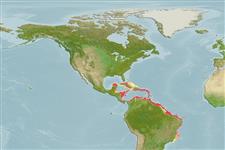>
Clupeiformes (Herrings) >
Pristigasteridae (Pristigasterids)
Etymology: Chirocentrodon: Greek, cheir = hand + Greek, kentron = sting + Greek, odous = teeth (Ref. 45335).
More on author: Poey.
Environment: milieu / climate zone / depth range / distribution range
ນິເວດວິທະຍາ
ສັດທະເລ; ນ້ຳກ່ອຍ; ລະດັບຄວາມເລິກ 20 - 60 m (Ref. 12225). Tropical; 24°N - 25°S, 90°W - 32°W (Ref. 188)
Western Atlantic: Cuba, Haiti, Jamaica, Puerto Rico, Trinidad; Panama and coasts of Venezuela, including off Orinoco mouth, Guyana, Suriname south to Ubatuba, near Santos, Brazil. Antilles and southern Caribbean from Yucatan to Santos, Brazil (Ref. 26938).
Length at first maturity / ຂະໜາດ / ນ້ຳໜັກ / Age
Maturity: Lm 7.6 range ? - ? cm
Max length : 16.1 cm TL ຕົວຜູ້/ບໍ່ມີເພດ; (Ref. 118626); common length : 9.0 cm TL ຕົວຜູ້/ບໍ່ມີເພດ; (Ref. 5217); ນ້ຳໜັກສູງສຸດທີ່ເຄຍຈັດພີມມາ: 19.30 g (Ref. 118626)
ຄີ (ໜາມ)ແຂງຢູ່ຫຼັງປາ (ທັງໝົດ): 0; ຄີ(ໜາມ) ແຂງຢູ່ຄີກົ້ນປາ
ກຸ່ມປາກະດູກແຂງ
ຄວາມຖີ່ຂອງກຸ່ມຖ່າຍທອດພັນ
ປາທີ່ມີການເຄື່ອນຍ້າຍຈາກທະເລໄປຫານ້ຳຈືດ ແລະນ້ຳຈືດຫາທະເລ
ປາທີ່ມີການເຄື່ອນຍ້າຍຈາກທະເລແລະໄປໄຂ່ຢູ່ນ້ຳຈືດ
ຄີກົ້ນຂອງປາ
ສັດທີ່ມີກະດູກສັນຫັຼງ
ການຖ່າຍທອດທາງກຳມະພັນຈາກພໍ່ແມ່ຫາລູກ 0; ຄີກົ້ນຂອງປາ: 38 - 44. Belly with 16 or 17 (rarely 19) + 9 to 11, total 26 to 28 (rarely 30) scutes. Lower jaw not strongly projecting; strong conical teeth in both jaws, continued as large and small teeth along maxilla blade. Easily recognized by large, canine-like teeth in both jaws (Ref. 26938). Dorsal fin origin behind midpoint of body; anal fin moderately long, its origin below or in front of dorsal fin origin.
Occurs in coastal areas, but also in lagoons and off river mouths, perhaps entering water of lowered salinity (Ref. 12225). In Southwestern Atlantic preys on proportionally large clupeoid fishes and caridean shrimps. Fishes are distinctively folded in the stomachs of this herring, in about 90% of the cases with their heads and tails pointing head-wards the predator. This herring stands out as the only small-sized species among the predaceous fish-eating clupeiforms. The well developed canine-like teeth are likely related to a piscivorous diet and may play a role in the folding and orientation of fish during prey handling and swallowing (Ref. 51383). Spawns during the northern winter (Ref. 37032).
Life cycle and mating behavior
ການຈະເລີນເຕັມໄວ | ການສືບພັນ | ການວາງໄຂ່ | ໄຂ່ | ຄວາມດົກຂອງໄຂ່ປາ | ຕົວອ່ອນ
Whitehead, P.J.P., 1985. FAO Species Catalogue. Vol. 7. Clupeoid fishes of the world (suborder Clupeoidei). An annotated and illustrated catalogue of the herrings, sardines, pilchards, sprats, shads, anchovies and wolf-herrings. FAO Fish. Synop. 125(7/1):1-303. Rome: FAO. (Ref. 188)
IUCN Red List Status (Ref. 130435)
Threat to humans
Harmless
Human uses
ການປະມົງ: ການປະມົງແບບກຸ້ມຕົນເອງ
ຂໍ້ມູນຕື່ມອີກ
ເອກະສານອ້າງອີງການລ້ຽງສັດນ້ຳຂໍ້ມູນການລ້ຽງສັດນ້ຳສາຍພັນກຳມະພັນElectrophoresesການຖ່າຍທອດທາງກຳມະພັນຈາກພໍ່ແມ່ຫາລູກພະຍາດການປຸງແຕ່ງNutrientsMass conversion
ຜູ້ຮ່ວມມືຮູບStamps, Coins Misc.ສຽງຫອຍມີພິດຊະນິດນຶ່ງທີ່ອາໄສໃນທະເລຄວາມໄວປະເພດການລອຍເນື້ອທີ່ເຫືອກOtolithsສະໝອງວິໄສທັດ
ເຄື່ອງມື
Special reports
Download XML
ແຫຼ່ງອີນເຕີເນັດ
Estimates based on models
Preferred temperature (Ref.
123201): 25.2 - 27.7, mean 27.1 °C (based on 45 cells).
Phylogenetic diversity index (Ref.
82804): PD
50 = 1.0000 [Uniqueness, from 0.5 = low to 2.0 = high].
Bayesian length-weight: a=0.00427 (0.00298 - 0.00611), b=3.02 (2.92 - 3.12), in cm total length, based on LWR estimates for this species (Ref.
93245).
ຊັ້ນເຂດຮ້ອນ (Ref.
69278): 3.3 ±0.43 se; based on food items.
ຄວາມຢືດຢຸ່ນ (Ref.
120179): ສູງ, ປະຊາກອນຕຳ່ສຸດທີ່ໃຊ້ເວລາສອງໜ້ອຍກວ່າ 15 ເດືອນ (Preliminary K or Fecundity.).
Fishing Vulnerability (Ref.
59153): Low vulnerability (10 of 100).
